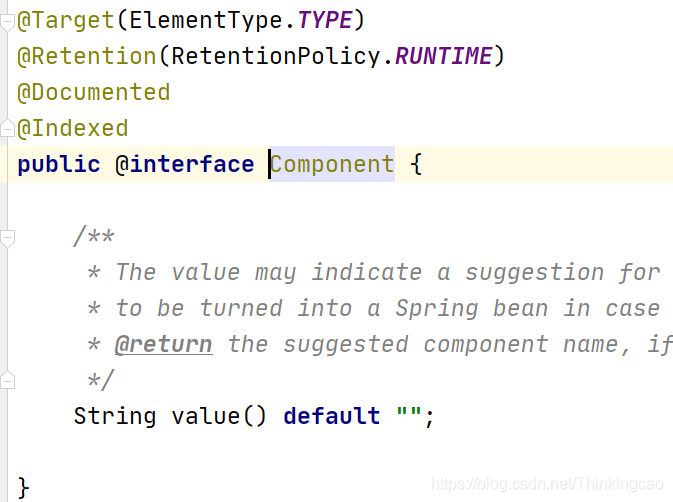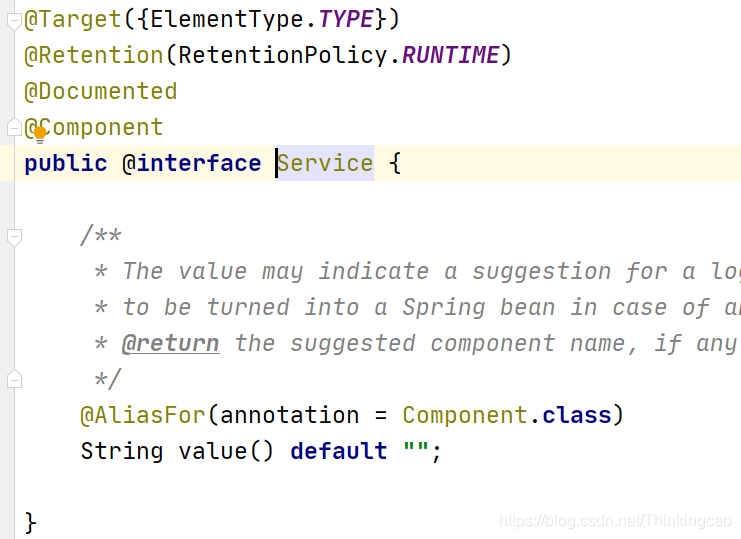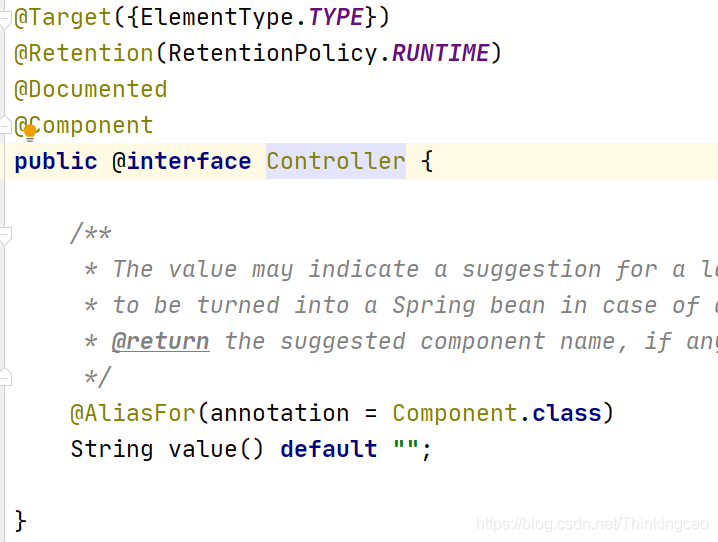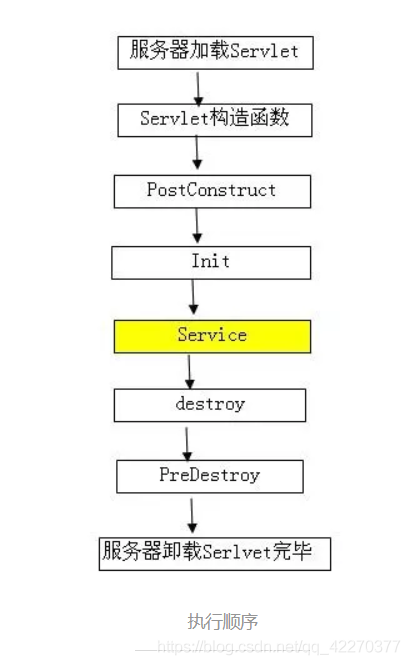关于@Component注解的含义说明
目录
- 一、注解分类
- 二、@Component 注解含义
- 三、基于@Component扩展的注解
- 四、component的扫描组件
- 五、方法初始化和销毁
- 1. @PostConstruct注解
- 2. @PreDestroy注解
- 3. 示例
一、注解分类
1、@controller:controller控制器层(注入服务)
2、@service:service服务层(注入dao)
3、@repository:dao持久层(实现dao访问)
4、@component:标注一个类为Spring容器的Bean,(把普通pojo实例化到spring容器中,相当于配置文件中的<bean id="" class=""/>)
二、@Component 注解含义
@Component: 标注Spring管理的Bean,使用@Component注解在一个类上,表示将此类标记为Spring容器中的一个Bean。

三、基于@Component扩展的注解
@Repository:
@Repository本身是基于@Component注解的扩展,被@Repository注解的POJO类表示DAO层实现,从而见到该注解就想到DAO层实现,使用方式和@Component相同;

@Service:
@Service本身是基于@Component注解的扩展,被@Service注解的POJO类表示Service层实现,从而见到该注解就想到Service层实现,使用方式和@Component相同;

@Controller:
@Controller本身是基于@Component注解的扩展,被@Controller注解的类表示Web层实现,从而见到该注解就想到Web层实现,使用方式和@Component相同;

Tips:使用@Component,@Service,@Controller,@Repository注解的类,表示把这些类纳入到spring容器中进行管理,同时也是表明把该类标记为Spring容器中的一个Bean。
四、component的扫描组件
下面写这行配置是引入component的扫描组件
<context:component-scan base-package=”com.mmnc”>
其中base-package为指定需要扫描的包(含所有子包) ,扫描被@Service、@Controller、@Repository、@Component等注解标注的Java类,将其扫描注入到Spring容器,注入成Bean:
@Service用于标注业务层组件@Controller用于标注控制层组件(如struts中的action)@Repository用于标注数据访问组件,即DAO组件.@Component泛指组件,当组件不好归类的时候,我们可以使用这个注解进行标注,标识为一个Bean。
五、方法初始化和销毁
从Java EE5规范开始,Servlet增加了两个影响Servlet生命周期的注解: @PostConstruct和@PreConstruct ,这两个注解被用来修饰一个非静态的void()方法,而且这个方法不能有抛出异常声明,标注方法的初始化和销毁,当你需要在系统启动时提前设置一下变量或者设置值操作时,可以使用@PostConstruct注解进行项目启动时设置来完成,当你需要处理关闭资源或者发送通知相关操作时可以使用@PreConstruct 完成。
1. @PostConstruct注解
被@PostConstruct修饰的方法会在服务器加载Servlet的时候运行,并且只会被服务器调用一次,类似于Servlet的inti()方法。被@PostConstruct修饰的方法会在构造函数之后,init()方法之前运行。
2. @PreDestroy注解
被@PreDestroy修饰的方法会在服务器卸载Servlet的时候运行,并且只会被服务器调用一次,类似于Servlet的destroy()方法。被@PreDestroy修饰的方法会在destroy()方法之后运行,在Servlet被彻底卸载之前。
加载顺序如图:

在Spring中可以使用以下方式指定初始化方法和销毁方法(方法名任意):
//对象创建并赋值之后调用
@PostConstruct
public void init() {
System.out.println("对象创建并赋值之后调用...");
}
和
//容器移除对象之前
@PreDestroy
public void detory(){
System.out.println("容器移除对象之前执行...");
}
3. 示例
@Controller
@Lazy(false)
public class ServletInit {
@Autowired
private PCASigninServlet pcaSigninServlet;
@Autowired
private PCASignoutServlet pcaSignoutServlet;
@Autowired
private PCAInitServlet pcaInitServlet;
@Autowired
private PCALogoutServlet pcaLogoutServlet;
@Autowired
private PCAInfoServlet pcaInfoServlet;
@Autowired
private HelloServlet helloServlet;
@Autowired @Qualifier("handler")
private WebAppContext webapp;
@PostConstruct
void init(){
Server server = new Server(8848);
ServletContextHandler contextHander = new ServletContextHandler(ServletContextHandler.SESSIONS);
contextHander.setContextPath("/");
System.out.println("start init");
HandlerCollection hc =new HandlerCollection();
hc.setHandlers(new Handler[]{webapp, contextHander});
server.setHandler(hc);
System.out.println("addServlet /hello");
contextHander.addServlet(new ServletHolder(helloServlet), "/hello");
contextHander.addServlet(new ServletHolder( pcaSigninServlet), "/pca/signin");
contextHander.addServlet(new ServletHolder( pcaSignoutServlet), "/pca/signout");
contextHander.addServlet(new ServletHolder( pcaInitServlet), "/pca/init");
contextHander.addServlet(new ServletHolder( pcaLogoutServlet), "/pca/logout");
contextHander.addServlet(new ServletHolder( pcaInfoServlet), "/pca/info");
try
{
System.out.println("server start");
server.start();
server.join();
System.out.println("server stop");
} catch (Exception e)
{
e.printStackTrace();
}
}
}
以上为个人经验,希望能给大家一个参考,也希望大家多多支持我们。

